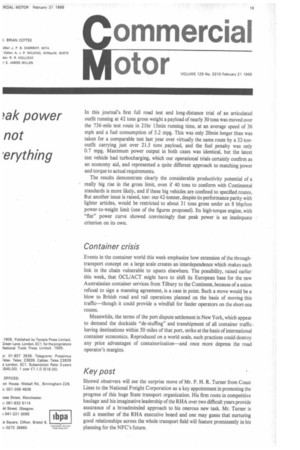ommercial otor
Page 21

If you've noticed an error in this article please click here to report it so we can fix it.
In this journal's, first full road test and long-distance trial of an articulated outfit running at 42 tons gross weight a payload of nearly 30 tons was moved over the 736-mile test route in 21hr 13min running time, at an average speed of 36 mph and a fuel consumption of 5.2 mpg. This was only 20min longer than was taken for a comparable test last year over virtually the same route by a 32-tonoutfit carrying just over 21.5 tons payload, and the fuel penalty was only 0.7 mpg. Maximum power output in both cases was identical, but the latest test vehicle had turbocharging, which our operational trials certainly confirm as an economy aid, and represented a quite different approach to matching power and torque to actual requirements.
The results demonstrate clearly the considerable productivity potential of a really big rise in the gross limit, even if 40 tons to conform with Continental standards is more likely, and if these big vehicles are confined to specified routes. But another issue is raised, too: our 42-tonner, despite its performance parity with lighter articles, would be restricted to about 31 tons gross under an 8 bhp/ton power-to-weight limit (one of the figures proposed). Its high-torque engine, with "flat" power curve showed convincingly that peak power is an inadequate criterion on its own.
Container crisis
Events in the container world this week emphasize how extension of the throughtransport concept on a large scale creates an interdependence which makes each link in the chain vulnerable to upsets elsewhere. The possibility, raised earlier this week, that OCL/ACT might have to shift its European base for the new Australasian container services from Tilbury to the Continent, because of a union refusal to sign a manning agreement, is a case in point. Such a move would be a blow to British road and rail operations planned on the basis of moving this traffic—though it could provide a windfall for feeder operators on the short-sea routes.
Meanwhile, the terms of the port dispute settlement in New York, which appear to demand the dockside "de-stuffing" and transhipment of all container traffichaving destinations within 50 miles of that port, strike at the basis of international container economics. Reproduced on a world scale, such practices could destroy any price advantages of containerization—and once more depress the road operator's margins.
Key post
Shrewd observers will see the surprise move of Mr. P. H. R. Turner from Coast Lines to the National Freight Corporation as a key appointment in promoting the progress of this huge State transport organization. His firm roots in competitive haulage and his imaginative leadership of the RHA over two difficult years provide assurance of a broadminded approach to his onerous new task. Mr. Turner is still a member of the RHA executive board and one may guess that nurturing good relationships across the whole transport field will feature prominently in his planning for the NFC's future.












































































































